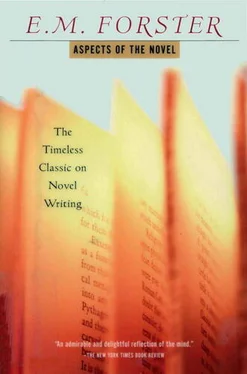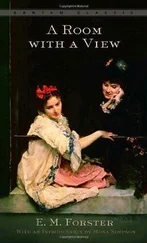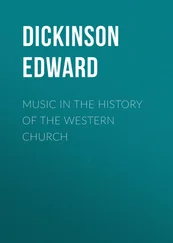Emily Brontë had in some ways a literal and careful mind. She constructed her novel on a time chart even more elaborate than Miss Austen's, and she arranged the Linton and Earnshaw families symmetrically, and she had a clear idea of the various legal steps by which Heathcliffe gained possession of their two properties. [8] See that sound and brilliant essay, The Structure of Wuthering Heights, by C.P.S., Hogarth Press.
Then why did she deliberately introduce muddle, chaos, tempest? Because in our sense of the word she was a prophetess: because what is implied is more important to her than what is said; and only in confusion could the figures of Heathcliffe and Catherine externalize their passion till it streamed through the house and over the moors. Wuthering Heights has no mythology beyond what these two characters provide: no great book is more cut off from the universals of Heaven and Hell. It is local, like the spirits it engenders, and whereas we may meet Moby Dick in any pond, we shall only encounter them among the harebells and limestone of their own county.
A concluding remark. Always, at the back of my mind, there lurks a reservation about this prophetic stuff, a reservation which some will make more strongly while others will not make it at all. Fantasy has asked us to pay something extra; and now prophecy asks for humility and even for a suspension of the sense of humour, so that we are not allowed to snigger when a tragedy is called Billy Budd. We have indeed to lay aside the single vision which we bring to most of literature and life and have been trying to use through most of our inquiry, and take up a different set of tools. Is this right? Another prophet, Blake, had no doubt that it was right.
May God us keep
From single vision and Newton's sleep,
he cried and he has painted that same Newton with a pair of compasses in his hand, describing a miserable mathematical triangle, and turning his back upon the gorgeous and immeasurable water growths of Moby Dick. Few will agree with Blake. Fewer will agree with Blake's Newton. Most of us will be eclectics to this side or that according to our temperament. The human mind is not a dignified organ, and I do not see how we can exercise it sincerely except through eclecticism. And the only advice I would offer my fellow eclectics is: "Do not be proud of your inconsistency. It is a pity, it is a pity that we should be equipped like this. It is a pity that Man cannot be at the same time impressive and truthful." For the first five lectures of this course we have used more or less the same set of tools. This time and last we have had to lay them down. Next time we shall take them up again, but with no certainty that they are the best equipment for a critic or that there is such a thing as a critical equipment.
OURinterludes, gay and grave, are over, and we return to the general scheme of the course. We began with the story, and having considered human beings, we proceeded to the plot which springs out of the story. Now we must consider something which springs mainly out of the plot, and to which the characters and any other element present also contribute. For this new aspect there appears to be no literary word—indeed the more the arts develop the more they depend on each other for definition. We will borrow from painting first and call it the pattern. Later we will borrow from music and call it rhythm. Unfortunately both these words are vague —when people apply rhythm or pattern to literature they are apt not to say what they mean and not to finish their sentences: it is, "Oh, but surely the rhythm . . . or "Oh, but if you call that pattern . . ."
Before I discuss what pattern entails, and what qualities a reader must bring to its appreciation, will give two examples of books with patterns so definite that a pictorial image sums them up: a book the shape of an hour-glass and a book the shape of a grand chain in that old-time dance, the Lancers.
Thais by Anatole France is the shape of an hour-glass.
There are two chief characters, Paphnuce the ascetic, Thais the courtesan. Paphnuce lives in the desert, he is saved and happy when the book starts. Thais leads a life of sin in Alexandria, and it is his duty to save her. In the central scene of the book they approach, he succeeds; she goes into a monastery and gains salvation, because she has met him, but he, because he has met her, is damned. The two characters converge, cross, and recede with mathematical precision, and part of the pleasure we get from the book is due to this. Such is the pattern of Thais —so simple that it makes agood starting-point for a difficult survey. It is the same as the story of Thais, when events unroll in their time-sequence, and the same as the plot of Thais, when we see the two characters bound by their previous actions and taking fatal steps whose consequence they do not see. But whereas the story appeals to our curiosity and the plot to our intelligence, the pattern appeals to our aesthetic sense, it causes us to see the book as awhole. We do not see it as an hour-glass—that is the hard jargon of the lecture room which must never be taken literally at this advanced stage of our inquiry. We just have a pleasure without knowing why, and when the pleasure is past, as it is now, and our minds are left free to explain it, a geometrical simile such as an hour-glass will be found helpful. If it was not for this hour-glass the story, the plot, and the characters of Thais and Paphnuce would none of them exert their full force, they would none of them breathe as they do. "Pattern," which seems so rigid, is connected with atmosphere, which seems so fluid.
Now for the book that is shaped like the grand chain: Roman Pictures by Percy Lubbock.
Roman Pictures is a social comedy. The narrator is a tourist in Rome; he there meets a kindly and shoddy friend of his, Deering, who rebukes him superciliously for staring at churches and sets him out to explore society. This he does, demurely obedient; one person hands him on to another; café, studio, Vatican and Quirinal purlieus are all reached, until finally, at the extreme end of his career he thinks, in a most aristocratic and dilapidated palazzo, whom should he meet but the second-rate Deering; Deering is his hostess's nephew, but had concealed it owing to some backfire of snobbery. The circle is complete, the original partners have rejoined, and greet one another with mutual confusion which turns to mild laughter.
What is so good in Roman Pictures is not the presence of the "grand chain" pattern—anyone can organize a grand chain—but the suitability of the pattern to the author's mood. Lubbock works all through by administering a series of little shocks, and by extending to his characters an elaborate charity which causes them to appear in a rather worse light than if no charity was wasted on them at all. It is the comic atmosphere, but sub-acid, meticulously benign. And at the end we discover to our delight that the atmosphere has been externalized, and that the partners, as they click together in the marchesa's drawing-room, have done the exact thing which the book requires, which it required from the start, and have bound the scattered incidents together with a thread woven out of their own substance.
Thais and Roman Pictures provide easy examples of pattern; it is not often that one can compare a book to a pictorial object with any accuracy, though curves, etc., are freely spoken of by critics who do not quite know what they want to say. We can only say (so far) that pattern is an aesthetic aspect of the novel, and that though it may be nourished by anything in the novel—any character, scene, word—it draws most of its nourishment from the plot. We noted, when discussing the plot, that it added to itself the quality of beauty; beauty a little surprised at her own arrival: that upon its neat carpentry there could be seen, by those who cared to see, the figure of the Muse; that Logic, at the moment of finishing its own house, laid the foundation of a new one. Here, here is the point where the aspect called pattern is most closely in touch with its material; here is our starting point. It springs mainly from the plot, accompanies it like a light in the clouds, and remains visible after it has departed. Beauty is sometimes the shape of the book, the book as a whole, the unity, and our examination would be easier if it was always this. But sometimes it is not. When it is not I shall call it rhythm. For the moment we are concerned with pattern only.
Читать дальше












